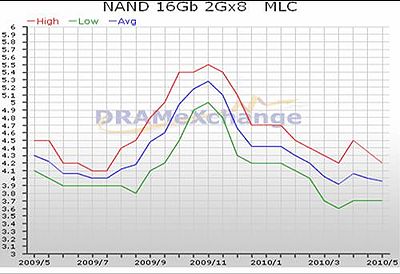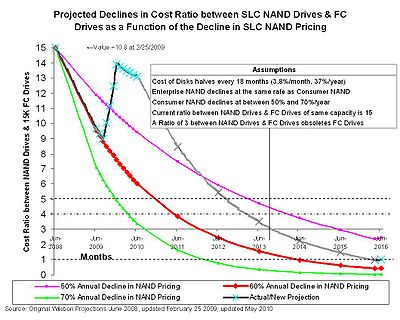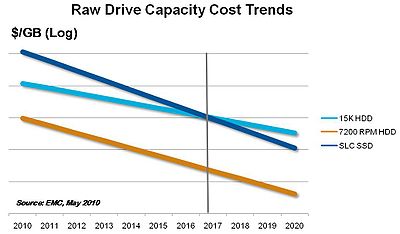Contents |
Impact of Recession on Flash Prices
Wikibon earlier projected the comparative price declines of flash drives and FC drives. The projection was that flash drives would come down at 60% every year. That rate held until July 2009, when the scenario changed.

Source: DRAMeXchange, May 2010, http://www.dramexchange.com/WeeklyResearch/Post/2/2368.html downloaded 5/18/2010
Then came the impact of the recession, and the market became very different. Instead of the normal 7% per month decrease in prices, Figure 1 shows that prices then when up by 7.29% per month for the next four months. After the peak in November 2009, it has come down again by an average of 4.74% per month for the last six months.
Revised Flash Price Projections
There can be different interpretations of this change:
- Is this a bump in the road caused by the reduction in supply by memory manufacturers as a result of the recession, and it will now drop by the original 60% per year from now (or very soon)?
- Will flash prices now drop faster until they meet the original projection as more capacity comes online, and then go back to the original 60% per year reduction?
- Are more profound changes ahead in the marketplace and ecosystem that will decrease the original projection price-reduction rates for flash to (say) 4.74%.month (44%/year)?
Wikibon has formulated its projections using the first interpretation. The main reason for choosing this is that fundamental change in storage derives from the consumer market. Flash dominates consumer electronics. The new iPads from Apple use up to 64GB of flash. Not only are the power characteristics amazing (10+ hours of battery life), but the user experience is fantastic. If you do a side-by-side performance comparison between an iPad and a traditional hard-drive notebook on any normal activity, the iPad wins hands down. The response time is two to ten times faster; the user is more productive and has more fun.
The stark conclusion is that, despite the attempts of Microsoft to slow down flash-only adoption, notebooks and tablets will become increasingly flash-only. Flash will dominate and completely change the design of the storage hierarchy. The markets for disk drives will shrink and focus on cheap capacity. The innovation engine for disk drives has come and gone.
The new projection is shown in Figure 2. It shows that FC disks will be less than three times the costs of flash drives in 2013, instead of 2011, at which time FC disks will be difficult to justify because of cost of providing the disk infrastructure, power, maintenance, and much poorer performance and availability. It shows that the lines finally cross in 2016.
Figure 3 shows a similar marketing projection from EMC, focusing on a projection of the raw cross-over date in $cost/GB in 2017.
What does this mean for users and vendors in the enterprise IT space?
With investment in traditional disks a thing of the past, the disk market will go the way of tape; needed, good revenue numbers, but declining profit margins and importance.
Let’s go back to the iPad. The user response time experience is enhanced by flash storage. The applications are being written anew to take advantage of both the user interface and the flash storage medium. “Save” is a thing of the past. Much more data can be obtained to improve the user “smile” factor.
Flash forward to enterprise applications – flash will allow applications much faster access to data, microseconds instead of milliseconds, a hundred to a thousand times more data per tap. Server chips such as Intel’s Nehalem have the bandwidth and processor power but will need to be packaged with a different memory hierarchy. The memory architecture is now completely different, with flash taking part in both the server and storage arrays.
To allow applications to exploit this, operating systems and databases will have to be reengineered to take advantage of the persistent nature of flash. Both server and storage vendors will make new partnerships with flash providers and other suppliers in the stack. New integrated stacks will become available from individual vendors and partnerships.
Conclusion
Server and storage array vendors will no longer be beholden to Seagate product plans and will need to forge new alliances with flash suppliers. Mobile devices will dominate access to enterprise data centers.
Action Item: Clear a pathway for flash adoption, and exploit the business potential for high-function data centric applications that will radically improve productivity for employees, partners and customers. Put the smile back into computing.
Footnotes:







